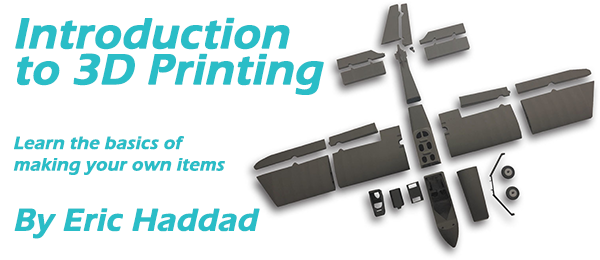Article by Paul Gentile
In the 1980s early 3-D printing laid the groundwork for the technology today.
Supplemental article to 3D Printing for Aeromodeling in the October 2013 Model Aviation.
The history of 3-D printing started with the birth of the inkjet printer in 1976 and by 1984 inkjet technology evolved to material printing. Charles Hull was the inventor who made that leap and patented the stereolithography process. Stereolithography (STL) is the process of solidifying a photopolymer with a UV laser. Layer by layer the laser solidifies the liquid and a 3-D object is created.
Hull was a cofounder of 3-D Systems and in the early 1990s build the first practical 3-D printer based on the stereolithography process. Although imperfect, the practical 3-D printer was born and the ability to print an object from a 3-D digital file changed the world of manufacturing. Every industry could now print out prototypes before sending them for tooling, saving time and money in the process.
The 1980s were ripe with experiments around 3-D printing. In the late 1980s, S. Scott Crump, founder of Stratasys, invented the Fused Deposition Modeling (FDM) method of 3-D printing. Similar to how a hot glue gun works, a material is extruded through a heated nozzle that melts the material while it is being deposited. As the material cools, it solidifies and layer by layer the product is created. This is the technology that today most open source 3-D printers use.
There are other 3-D printing technologies on the market as well. Generally the more complicated the process, the more expensive they are. Methods such as Granular Materials Binding that use selective laser sintering (SLS) or electron beam melting (EBM) can be found in universities or large corporations.
Other technologies employ lamination techniques and variants on photopolymerization techniques. All 3-D printing starts with a 3-D computer model that is digitally sliced into layers and then passed to the printer. Each of those layers is created in succession until the object is complete.
The current 3-D printing revolution started in 2005 when Dr. Adrian Bowyer, a senior lecturer in mechanical engineering at the University of Bath in the United Kingdom, proposed the idea for a self-replicating machine. The RepRap project came to life in the spring of 2007 when the first RepRap, named Darwin, was finished.
Its RepRap parts were made on a Stratasys Dimension Printer. Darwin became humanity’s first general-purpose, self-replicating manufacturing machine. The RepRap is a 3-D printer with a design that is free and open for all to share and build. The expiration of some key FDM patents, the simplicity of the technology, and a community of enthusiasts has meant that there have been hundreds of designs built from the original RepRap Darwin.
In 2009, MakerBot Industries, founded by Adam Mayer, Zach Smith, and Bre Pettis of Brooklyn, New York, began selling the first commercially available FDM printer kits known as the CupCake CNC. The Cupcake was a 3-D printer with RepRap heritage.
The kit consisted of laser-cut wood parts, off-the-shelf hardware, and 3-D printed components. The kit sold for $750 and was groundbreaking considering that the only alternative at the time was to scratch-build your own or buy a $15,000 commercial printer.
Its low cost and ease of building made the CupCake CNC a success and its open nature inspired countless revisions and tangent designs. As the popularity of the CupCake grew, MakerBot introduced new printers with more features such as larger build areas and better resolution. In 2012 the MakerBot Replicator 2 was released which boasted a 410 cu. in. build area and a resolution of 100 microns—impressive for a printer that costs less than $1,500.
The open nature of 3-D printers has accelerated print technology and the open nature of the printed objects has accelerated the techniques for creating better prints. As designers continue to create more complex prints, software and hardware innovations follow suit to maximize print resolution, create new printing techniques, use less material, and exploit new ways to achieve better prints.
Although many online 3-D printing forums and wikis exist, it was MakerBot Industries that created Thingiverse.com, an online community where members can easily and freely share digital designs for 3-D printing, CNC, or laser cutting. Thingiverse has a community-based catalog of 3-D objects that you can download and print, or upload and share. Members share their designs online and license them under open source licenses so that you and I can print and create new works from those files.
—Paul Gentile
Image










Comments
Add new comment